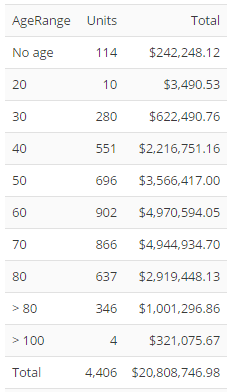Age Range Giving Units¶
This script shows the Age Range and totals for number of giving units (households) and amounts.
You can modify the parameters at the top of the script to filter by the year/starting month, campus, fundid, member status and main fellowship indicator.

Sample Report¶
The recommended name is AgeRangeGivingUnits
Use the following code to Create the SQL Script. See How to create a SQL Script.
-- Parameters
DECLARE
@fiscalstartmonth INT = 1
,@year INT = 2015
,@fundid INT = 1
,@mintotal INT = 100
,@memberstatusid INT = NULL
,@inmainfellowship BIT = NULL
,@campusid INT = 0
DECLARE @fromdt DATETIME = DATETIMEFROMPARTS(@year, @fiscalstartmonth, 1, 0, 0, 0, 0)
DECLARE @todt DATETIME = DATEADD(DAY, -1, DATEADD(YEAR, 1, @fromdt))
-- Constants
DECLARE
@nontaxded BIT = 0
,@pledges BIT = 0
,@includeUnclosed BIT = 1
;WITH gifts AS (
SELECT
c2.FamilyId,
c2.FundId,
[Count] = COUNT(*),
Amount = SUM(c2.Amount),
PledgeAmount = SUM(c2.PledgeAmount)
FROM dbo.Contributions2(@fromdt, @todt, @campusid, @pledges, @nontaxded, @includeUnclosed, NULL) c2
GROUP BY c2.FamilyId, c2.FundId
),
units AS (
SELECT
hh.FamilyId,
Age = ISNULL(hh.Age, -1),
[Count] = COUNT(*),
Amount = SUM(tt.Amount)
FROM gifts tt
JOIN dbo.Families f ON f.FamilyId = tt.FamilyId
JOIN dbo.People hh ON hh.PeopleId = f.HeadOfHouseholdId
LEFT OUTER JOIN dbo.Organizations o ON o.OrganizationId = hh.BibleFellowshipClassId
WHERE (@fundid IS NULL OR tt.FundId = @fundid)
AND (@memberstatusid IS NULL OR @memberstatusid = hh.MemberStatusId)
AND (@inmainfellowship IS NULL OR @inmainfellowship = IIF(hh.BibleFellowshipClassId > 0, 1, 0))
GROUP BY hh.FamilyId, hh.Age
HAVING SUM(Amount) > @mintotal
),
ageranges AS (
SELECT
AgeRange = CASE
WHEN units.Age < 0 THEN 'No age'
WHEN units.Age <= 10 THEN '10'
WHEN units.Age <= 20 THEN '20'
WHEN units.Age <= 30 THEN '30'
WHEN units.Age <= 40 THEN '40'
WHEN units.Age <= 50 THEN '50'
WHEN units.Age <= 60 THEN '60'
WHEN units.Age <= 70 THEN '70'
WHEN units.Age <= 80 THEN '80'
WHEN units.Age <= 99 THEN '> 80'
ELSE '> 100'
END,
units.Age,
units.[Count],
units.Amount
FROM units
)
SELECT
AgeRange = ISNULL(r.AgeRange, 'Total'),
[Units] = SUM(r.Count),
[Total] = SUM(r.Amount)
FROM ageranges r
GROUP BY r.AgeRange WITH ROLLUP
ORDER BY
CASE WHEN r.AgeRange LIKE 'No%' THEN 0
WHEN r.AgeRange LIKE '> 8%' THEN 2
WHEN r.AgeRange LIKE '> 1%' THEN 3
WHEN r.AgeRange IS NULL THEN 4
ELSE 1
END, r.AgeRange
Latest Update |
11/13/2020 |
Modify image link with secure protocol.
